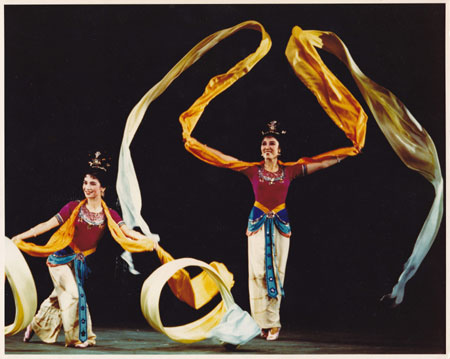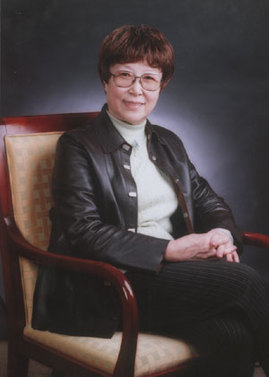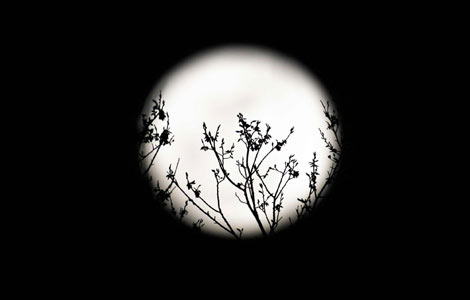People
The spirit of dance
Updated: 2011-03-16 08:06
By Mu Qian (China Daily)
She possesses just a junior middle school education but is a thesis adviser to PhD students. National first-level dancer Zi Huayun is the only dancer in China to be recognized as much for her academic research as for her performances. "The tragedy of a dancer is that when you have the most youthful and supple body, you don't really know the secret of dance, and when your mind becomes mature you body begins to age,?says the professor of dance with the Chinese National Academy of Arts.
|
 Zi Huayun (right) performs a dance featuring apsaras based on the female Buddhist spirits represented in the Dunhuang frescoes. Provided to China Daily |
Zi's best years as a dancer coincided with the "cultural revolution" (1966-1976), forcing her off the stage.
But she never stopped practicing, which stood her in good stead when she returned to the stage. However, she decided to retire in 1983 when she found herself unable to perform the dance routines of the past.
"It's so difficult to be a great dancer. It feels like (chasing after) someone you love but can never get," she once wrote in an essay.
Despite retiring from the stage, Zi, now 75, has been continuing her pursuit of dance but in another direction - academic research.
When she celebrated the 60th anniversary of her dance career in 2010, more than 400 people gathered to pay tribute to her, including directors of many dance troupes and educational organizations who used to study with her, as well as folk dancers from more than 20 ethnic groups who have worked with her.
Zi has performed the dances of many of China's ethnic groups, moving on to research them in later years.
|
 Zi, 75, continues her passion for dance through academic research. Hei Ming / for China Daily |
Currently deputy director of the National Expert Committee on Intangible Cultural Heritage Protection, Zi says China's rich folk dance culture is a crucial resource for the development of this art form.
Born into a banker's family in Tianjin, Zi's dream was to become a great ballerina. When she was 6, her mother took her to study ballet under a Russian teacher, who found in her a promising ballet talent.
Zi performed ballet for the expat community of Tianjin and was acclaimed as a prodigy, but it was a different form of dance that drew her further into the world of dance.
When Zi was 14, her father took her to see a performance titled Viva People's Victory, which involved a lot of Chinese folk dance. Unlike ballet, which is confined to a small circle, Chinese folk dance is full of splendor and flamboyance and changed Zi's understanding of dance.
"I didn't realize till then that dance could express people's emotions so directly and touch their souls," she says.
Zi was in her final year of junior middle school at the Tianjin Nankai School, a prestigious educational institute that has produced many VIPs in China's political and academic circles. With the highest score in her class she could have continued to study in the high school of Nankai without taking an exam. But overriding the objections of her parents and teachers, she chose to study dance in Beijing.
In 1950, Zi became the youngest student in the "youngsters' dance class" attached to the Central Academy of Drama, and the next year the youngest member of the first art troupe to perform abroad since the founding of New China.
Though Zi was forced to stop dancing during the "cultural revolution" and worked as a farmer for almost 10 years, her long career has seen her perform in more than 30 countries. And wherever she went, she tried to study the local dance tradition.
She also spent a lot of time studying China's own traditions, and her works include White Peacock of the Dai People, Spring Outing of the Tibetans, and Dance with Drum of the Uygur.
The work that won her most acclaim was Apsaras, choreographed by Zi's teacher Dai Ailian, based on the female Buddhist spirits, as represented in the Dunhuang frescoes.
By combining the Peking Opera techniques of waving long sleeves, with her dance movements, Zi animated the static image of the frescoes.
Apsaras is not only Zi's signature dance work, but also the starting point of her academic research.
"The (idea of) apsara is originally from India, but it has been absorbed into Chinese culture, and no one regards it as something alien today. That's how Chinese culture developed, by absorbing different cultural items with an open attitude," she says.
Zi maintains that today's Chinese dance needs to learn from the outside world, even while being rooted in China's own traditions. That's why she spends much of her time going to regions populated by ethnic groups and studying their dances.
In Zi's eyes, today's Chinese dance works are more about technique and spectacular scenes, than about a distinct dance language.
"Many of today's dance works resemble acrobatics. That's not the right way to go," she says. "I hope dancers and choreographers will spend more time studying our roots."
Using her knowledge from dance and anthropology, Zi started a new field of research she calls "dance ecology", which explores the relationship between folk dances and their natural and cultural ecological environment.
She spends most of her time now editing the encyclopedic China Research Series - Dance Volume, which is scheduled to be completed this year.
"The 60th anniversary of my dance career has become another starting point for me. I hope my work will become a ladder on which future dancers can climb to a higher level," she says.
E-paper

City of Joy
Welcome to the 'world of smiles' where life meanders slowly.
Preview of the coming issue
Debate on nuclear power revived
The future is now
Specials

Beloved polar bear died
Berlin's beloved polar bear Knut, an international star died Saturday.

Panic buying of salt
Worried Chinese shoppers stripped stores of salt on radiation fears.

'Super moon'
The "Super Moon" arrives at its closest point to the Earth in 2011.
